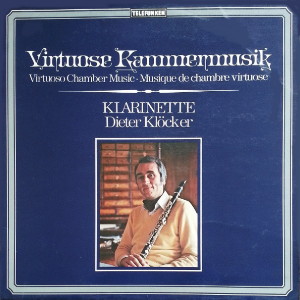 |
1 LP -
Telefunken 6.42830 AP (p) 1979
|
|
| VIRTUOSE KAMMERMUSIK -
Klarinette |
|
|
|
|
|
|
|
| Carl Marian von
Weber (1786-1826) |
Grand
Duo Concertante Es-dur für
Klarinette und Klavier, Op. 48 (J.
204) |
|
15' 14" |
A1 |
|
- Allegro
con fuoco |
5' 44" |
|
|
|
- Andante
con moto |
6' 17" |
|
|
|
- Rondo:
Allegro |
6' 13" |
|
|
|
Thema und
Variationen B-dur für
Klarinette und Klavier, Op. 33 (J.
128) |
|
14' 16" |
B1 |
|
Thema
(Andante con moto; Arie
der Mechtilde [Nr. 10a]
aud der Oper "Silvana")
und 7 Variationen |
|
|
|
|
Introduktion,
Thema und Variationen
B-dur für
Klarinette und
Streichquartett (1815) |
|
9' 47" |
B2 |
|
(Webers
Autorschaft wird
bezweifelt) |
|
|
|
|
|
|
|
|
| Dieter KLÖCKER,
Klarinette |
Mitglieder des
Consortium Classicum |
|
|
- Werner
Grobholz, Dietmar Forster,
Violine |
|
|
- Helmut Nicolai,
Viola |
|
|
- Helmar
Stiehler, Violoncello |
|
|
- Werner Genuit,
Klavier |
|
|
|
|
|
Luogo
e data di registrazione |
|
-
|
|
|
Registrazione:
live / studio |
|
studio |
|
|
Recording
Supervision
|
|
-
|
|
|
Edizione LP |
|
TELEFUNKEN
- 6.42830 AP - (1 LP - durata 39'
17") - (p) 1979 - Analogico |
|
|
Originale LP
|
|
- |
|
|
Prima Edizione CD |
|
-
|
|
|
Note |
|
-
|
|
|
|
|
The “Grand
Duo concertant
pour Pianoforte et
Clarinette” in
E-flat major, op
48 (J. 204) is the
only solo clarinet
work not composed
exclusively for
Heinrich Bärmann -
at least it lacks
a dedication to
him. This is
probably due to
the fact that
Weber began the
Grand Duo
initially as a
concerto (J. Anh.
II. 57) for
Bärmann's rival,
Johann Simon
Hermstedt
(1778-1846), when
in 1815 the latter
came to Prague. It
is very probable
that in Prague,
out of
consideration for
Bärmann, Weber
dropped the
concerto project
for Hermstedt, and
used what had
already been
accomplished for
our Grand Duo. At
any rate, since
the note on 4th
February, 1815
"comp. Savoyan
song and working
on Clar. Concerto
for Hermstedt,”
there were no more
follow-up entries
in Weber’s diary.
On the Munich
occasion in summer
1815 Weber then at
first worked on
the rondo and
adagio, the two
movements being
played there
separately by
Bärmann, in a
public concert on
2nd August,
together with
Weber’s first
piano concerto,
op. 11 (J. 98). It
was not until over
a year later,
between 5th and
8th November, 1816
that Weber than
also “notated the
first part of the
Duo in E-flat,"
most likelywith an
eyeto Schlesinger
to whom he had
already in july
sold the workin
advance.
Weber took the
theme of the
“seven Variations
for Clarinet and
Pianoforte" in
B-flat major, op.
33 (J. 128) from
the opera Silvana,
which he composed
in Stuttgart 1810;
it comes from the
aria of Mechtilde
"Warum muss' ich
dich je
erblicken?" Friend
Bärmann was again
the adressee of
this fourth work,
"for the
clarinet.”The work
appeared in print
on 22nd April,
1814 "according to
the delivery
catalogue of the
Schlesinger firm"
(Jähns).
A work which Weber
allegedly wrote in
Munich for
Bärmann’s name day
on 15th July,
1815,
"Introduction,
Theme and
Variations in
B-flat major for
Clarinet, 2
Violins, Viola and
Violoncello," has
meanwhile turned
out to be an
absolute forgery.
Concerning this,
the diary says on
the same day:
"Music for Heinr.
Bärmann notated
for his name day."
This Weber work
must meanwhile be
regarded as lost.
In reality the
variations
originated from
the ”Quintetto
pour Clarinette
Principale,
Violon, deux Altos
& Violoncelle,
composé &
dédié a son ami
Adam Schott, Œuvre
32" by Joseph
Küffner
(1776-1856), which
Schott had
published in Mainz
in March, 1815.
According to this,
Bärmann could
quite well have
known of the work
on his name day, a
circumstance which
favoured a
mystification à la
Weber.
Incidentally, the
version ascribed
to Weber is almost
identical with
that by Küffner:
only the first
viola was scored
for violin.
|
|
|

